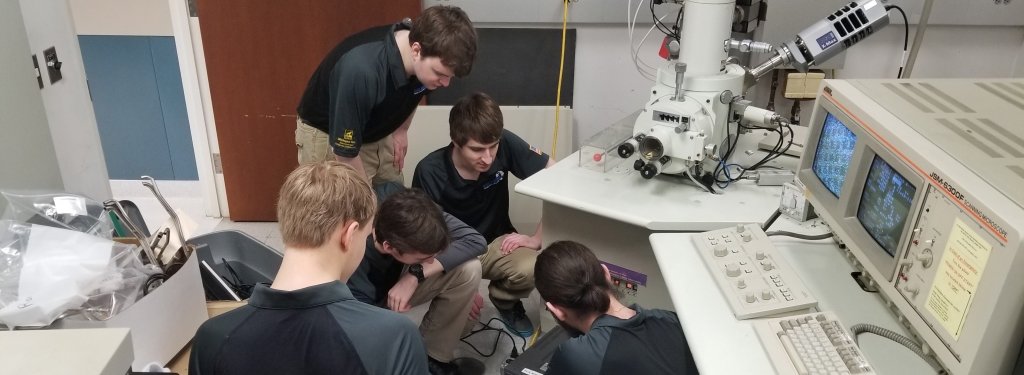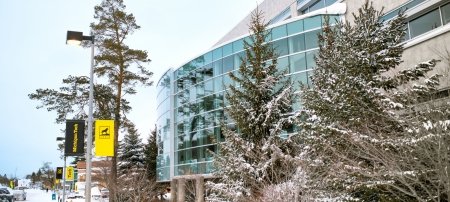A casual conversation in a Michigan Technological University hallway led to a discovery that will save Ford Motor Company hundreds of thousands of dollars.
A couple years ago, Glen Archer, interim chair of the Department of Electrical and Computer Engineering, bumped into Paul Sanders, the Patrick Horvath Endowed Professor of Material Science and Engineering. Sanders had a question for Archer — “Is Blue Marble looking for a project?”
Blue Marble Security, born out of the Michigan Tech Enterprise program, is a virtual company comprised of American and international undergraduate students focused on securing the future through thoughtful use of technology. Archer is the group’s advisor.
A Daunting Challenge
The project Sanders proposed to Archer was straightforward enough — make something old new again. Sanders came upon the challenge through a former colleague at Ford Motor Company, James Boileau. Like Sanders, Boileau is a metallurgist who routinely submits proposals to the Poling Prize, funded by the family of former Ford president, the late Harold Arthur “Red” Poling. The goal of the prize is to fund as many students as possible to solve important problems. And Boileau had a doozy.
Boileau ran the materials characterization lab at Ford’s Research and Innovation Center. An important piece of analytical equipment was in an older-model JEOL 6300 scanning electron microscope (SEM), which is similar to the JEOL 6400 at Michigan Tech. These SEMs use monitors with cathode ray tubes (CRT), essentially old-school TV tubes. CRTs are expensive, becoming hard to find and environmentally hazardous to dispose. Because JEOL was running out of spare monitors for its 6300, Ford’s 6300 SEM would become useless without new displays.
Taking Up the Challenge
Sanders pitched the problem to Archer, and Blue Marble went to work. The company’s goal was to replace the CRT monitors with off-the-shelf LED displays, similar to what you would find in most office computers. Success didn’t come early or easy. In fact, the project spanned two academic years. “The first year’s attempt produced some partial success in the sense that the students diligently uncovered a number of solutions that wouldn’t work very well,” Archer said with a smile.
He said those first attempts involved an examination of the CRT’s video signals. “I ruled this effort unsafe because of the high voltages involved and told the students to look deeper into the system to find the video signals while they are still at safe levels," Archer added.
"The student's examination of the schematics was nothing if not heroic."
Archer said the second year brought new insights, new leadership and eventually complete success. The students were given access to Tech’s JEOL 6400. In addition, Owen Mills, senior research engineer and director of the Applied Chemical and Morphological Analysis Laboratory in the Department of Materials Science and Engineering, provided printed schematics, operations and maintenance manuals. The search for a place to tap the video signals required the visual inspection and search of hundreds of pages of printed schematics. Finally Blue Marble found what they were looking for — a low-voltage signal in an early video display protocol pioneered by IBM called monochrome display adapter (MDA).
A Delicate Balance
Next came the delicate process of examining the signal characteristics to confirm that it was in fact a video signal. The test protocols were reviewed by Archer and Mills.
Archer said the team’s effort eventually paid off. “In the end, the video signal was available and adaptable to modern display protocols with a low-cost, commercial off-the-shelf adaptor.” The students designed an attractive case for the new monitor and had it 3D printed at the University library. The total system cost is less than $100.
After taking their final exams in April, several members of Blue Marble drove to Boileau’s lab in Dearborn, Michigan and in about two hours had installed their new system on his JEOL 6300.
The project team has also ordered the parts to produce a similar adaptor for Michigan Tech’s JEOL 6400. Installation will take place this fall. Archer stated, “Once discovered, this solution is easy and relatively inexpensive and has the potential to extend the service life of any of the JEOL 6000 series SEM systems that are deployed in industry and research labs around the world.”
A Timely Solution
For Boileau, the team’s installation could not have been better timed. One of the two monitors on the 6300 was beginning to lose contrast, limiting the use of the SEM. “The project is a complete success for both Michigan Tech and Ford. Having a clear image on a large monitor not only restores the system to full use but makes seeing the images much easier. The fact that any PC monitor can be used with the Michigan Tech adapter means that the SEM will be able to be used for years to come. This is why we chose Michigan Tech — we get access to outstanding engineering talent that maximizes a project's chance of success.”
Archer said Blue Marble’s latest success story is exactly why Michigan Tech students have such a fabulous reputation. “Given an unstructured problem and a supply of pizza and energy drinks, they were able to find a solution that meets the requirement at a price that thrills the accounting department. I couldn’t be prouder of them.”
Michigan Technological University is an R1 public research university founded in 1885 in Houghton, and is home to nearly 7,500 students from more than 60 countries around the world. Consistently ranked among the best universities in the country for return on investment, Michigan's flagship technological university offers more than 120 undergraduate and graduate degree programs in science and technology, engineering, computing, forestry, business, health professions, humanities, mathematics, social sciences, and the arts. The rural campus is situated just miles from Lake Superior in Michigan's Upper Peninsula, offering year-round opportunities for outdoor adventure.






Comments